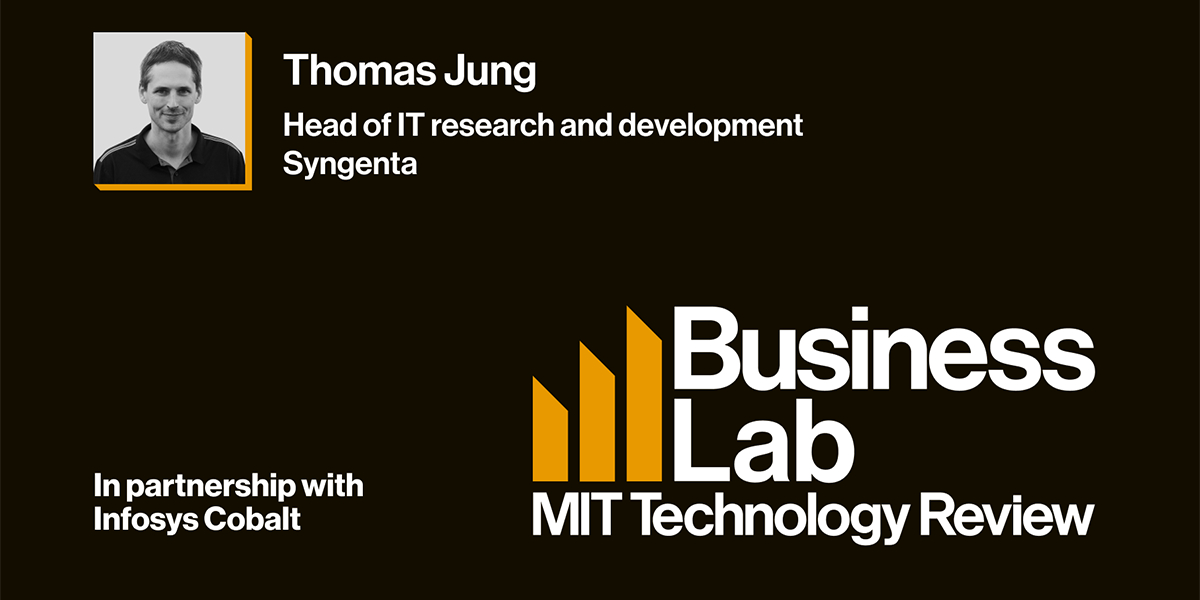
In the public sector, for example, just to call out a couple maybe. We’ve been working with the Open Data Institute to publish some of our data in a reusable format, raw data essentially, that scientists across the world can use, because we want to engage in that joint R&D practice. So there is data that we just share with the community, but we also care about data standards. So we’re a board member of AgGateway, that is a consortium of I think what 200 or more food sector companies working on how do we actually drive digital agriculture? So we’re making sure that the standards work for all and we don’t end up with proprietary ideas by each member of the food chain, but we can connect our data across.
The private sector, again, it’s just as important. We’re lucky enough to be headquartered in Basel, which is a cluster of science really, and of chemical sciences in particular. A lot of pharma companies are around here. So, we can also exchange a lot of what we learn between pharma and agriculture, we can learn about chemistry, we can learn about practices, how we work, how we work through our labs. We’re intensely in touch with our colleagues around the region here, but of course also elsewhere, and it’s quite a natural cluster.
Maybe last, not least, one of the real exciting perspectives for me that I realized, I don’t know, just couple of years ago, not many really, is how much there is if you look across industries. So, recently I hired somebody, a digital expert from Formula 1, and why that? I mean, if you look at this technically, steering or controlling, understanding a Formula 1 race car remotely isn’t much different from steering a tractor. I mean, the vehicles will be super different, but the technology in a way has a lot of similarities. So, understanding IoT in that case and understanding data transfer from the field to control centers, it doesn’t matter what industry we’re working on, we can learn all across.
We’re also working with a super experienced partner in the image recognition space to understand better what happens on the field, where as Syngenta, we can bring agronomic knowledge and that partner can bring technical knowledge on how to make most of the images. From a very different field, nothing to do with agriculture, but still the skills are super transferable. So, I’m really looking for talent across industries, and literally anybody who’s up for our cause, and not limited to people with life science experience.
Laurel Ruma: That’s really interesting thinking about how much data F1 processes on a single race day or just in general, the amount of inputs from so many different places. I can see how that would be very similar. You’re dealing with databases of data and just trying to build better algorithms to get to better conclusions. As you look around the larger community, you’re certainly seeing Syngenta is definitely part of an ecosystem, so how do outside factors like regulation and societal pressures help Syngenta build those better products to be part of and not outside of that unavoidable agricultural revolution?
Thomas Jung: It’s a great point, because regulatory in general, of course, is a practical burden to some, or may be perceived as one actually. But for us in digital science, it’s a very welcome driver of innovation. One of the key examples that we have at the moment is our work with the Environmental Protection Agency in the US, the EPA, which has stepped forward actually to stop supporting chemical studies on mammals by the year 2035. So, what does that mean? It sounds like a big threat, but really what it is, it’s a catalyst for digital science. So we very much welcome this request. We’re now working on ways to use data-based science to prove the safety of products that we invent. There’s couple of major universities across the US that have received funding from the EPA to help with finding those ways to do our science, so we are also engaging to make sure that we do this in the best possible way together and we can really land at a data-driven science here and we can stop doing all these real-life tests.
So, it’s a fantastic opportunity, but of course, a long way to go. I think 2035 is somewhat realistic. We’re not close yet. What we can do today is, for example, we can model a cell. There’s organ-on-a-chip as a big trend, so we can model up to a whole organ, but there’s no way we can model a system or even an ecosystem at this point. So, a lot of space for us to explore, and I’m really happy that regulators are a partner in this, and actually even a driver. That’s superbly helpful. The other dimension that you mentioned, societal pressure is also there. I think it is important that society keeps pushing for causes like regenerative agriculture, because this is what, first of all, creates the grounds for us to help with that. If there is no demand, it’s hard for Syngenta to push it forward alone.
So, I think the demand is important, and the awareness that we need to treat our planet the best possible way, and we’re also working with, for example, The Nature Conservancy, where we’re using their scientific, their conservation expertise to bring up sustainable agricultural practices in South America, for example, where we’re having some projects to restore rainforests, restore biodiversity, and see what we can do together there. So again, a bit like what we discussed before, we can only be better by collaborating across industries, and that includes NGOs as much as regulators and society as a whole.
